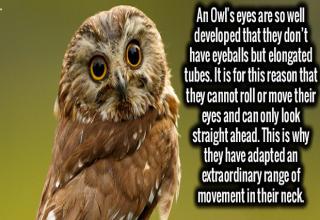Owls have eye tubes instead of eyeballs

Owls have eye tubes instead of eyeballs

Owls are fascinating creatures that possess incredible adaptations, some of which are quite unique. One of these intriguing features is their eyes. Contrary to popular belief, owls don’t actually have eyeballs. Instead, they have something called eye tubes, which set them apart from other birds and animals.
Unlike humans and most animals, an owl’s eyes are not spherical in shape. Instead, they are elongated and cylindrical, resembling tubes. These eye tubes are fixed in place within the bony sockets of an owl’s skull. The size of an owl’s eyes is also notable, as they are comparatively larger than those of most bird species.

So, what advantages do these eye tubes offer to owls? Firstly, the unusual shape provides owls with a much wider field of vision compared to humans. While human eyes have a limited range of motion, owls can rotate their eye tubes by up to 270 degrees, providing them with an almost complete 360-degree field of vision without turning their heads. This exceptional mobility allows owls to be highly perceptive, spotting prey, predators, or any potential danger from all directions.
Moreover, the size of an owl’s eye tubes allows more light to enter the eye, enhancing their night vision capabilities. Owls are renowned for their ability to see in almost total darkness, and this is partly due to the unique structure of their eyes. The increased light-gathering capacity allows them to collect more visual information, ensuring they can accurately locate small rodents or other prey even in dimly lit environments.
While the lack of traditional eyeballs may seem unusual, it showcases the fascinating evolutionary adaptations that owls possess. Their eye tubes provide them with exceptional visual capabilities, giving them an edge in their nocturnal hunting activities.
In conclusion, owls have eye tubes instead of eyeballs. These elongated and cylindrical structures enable them to have a wide field of vision and excellent night vision capabilities. This unique feature sets owls apart from most birds and animals, highlighting their fascinating adaptations for survival in their natural habitats.
Source: McGill University - Office for Science and Society
Tags
Share
Related Posts
Quick Links
Legal Stuff

